
The Allgemeiner Deutscher Nachrichtendienst (ADN), German for General German News Service, was the state news agency in the German Democratic Republic (GDR). It supplied news content to GDR newspapers and news broadcasters. [1]

The Allgemeiner Deutscher Nachrichtendienst (ADN), German for General German News Service, was the state news agency in the German Democratic Republic (GDR). It supplied news content to GDR newspapers and news broadcasters. [1]
The ADN was established in October 1946 as a GmbH (limited liability company) with the support of the Soviet Military Administration in Germany. In 1953, the GDR's ruling Socialist Unity Party (SED) ordered ADN GmbH dissolved and converted into a government agency with a monopoly on national and international news coverage. Although the ADN was officially subordinate to the Council of Ministers, the SED maintained a careful watch over it as the most important means of disseminating news to the public. In 1956, ADN assumed control over formerly independent photographic agencies in Berlin under the name ADN Zentralbild (ADN-ZB – German: Central Picture).
According to the ADN statute of 1966, its task was to report news in light of the ruling party's program, resolutions of the party's Central Committee and regulations issued by the GDR Council of State and Council of Ministers. Until the end of the 1970s, ADN compiled and distributed news via teleprinters. The ADN began converting to electronic text processing and transmission in 1979, using technology purchased from the Kyoto-based Omron Corporation.
Up to 1989, ADN employed approximately 1,400 people. It did not survive for long after German reunification in 1990. In May 1992, reduced to a staff of 254 and unable to compete with West German news services, the firm was sold to the Deutsche Depeschendienst (German Telegraphic Service). The collection of approximately one million historical photos preserved by ADN Zentralbild, some dating back to the earliest years of photography, were acquired by the German Federal Archives in Koblenz.
The ADN exercised a monopoly over the wire-service business in the GDR, supplying news dispatches, reports, articles and photographs to nearly all newspapers and radio and television broadcasters in the GDR. While newspapers and other periodicals also maintained their own staffs of reporters and editors, ADN set the overall standards for media in the GDR.
Coverage was divided into two categories, Inland (domestic) and Ausland (foreign). Ausland coverage included the political and economic situations in other countries, including the Federal Republic of Germany. All other areas, including politics, the economy. culture, education, science and sports, were considered Inland. There was a separate reporting service for news related to the Council for Mutual Economic Assistance, the economic community of socialist states.
ADN maintained domestic bureaus in each of the GDR's fifteen governmental districts, or Bezirke, including East Berlin, as well as a network of foreign offices in socialist and capitalist states. The ADN's foreign correspondents not only covered international news but also supplied the GDR government with confidential reports and news analysis from the countries to which they were assigned.

East Germany, officially known as the German Democratic Republic, was a country in Central Europe from its formation on 7 October 1949 until its reunification with West Germany on 3 October 1990. Until 1989, it was generally viewed as a communist state and described itself as a socialist "workers' and peasants' state". The economy of this country was centrally planned and state-owned. Although the GDR had to pay substantial war reparations to the Soviets, it became the most successful economy in the Eastern Bloc.

The Socialist Unity Party of Germany was the founding and ruling party of the German Democratic Republic from the country's foundation in 1949 until its dissolution after the Peaceful Revolution in 1989. It was a Marxist–Leninist communist party, established in 1946 as a merger of the East German branches of the Communist Party of Germany and Social Democratic Party of Germany.
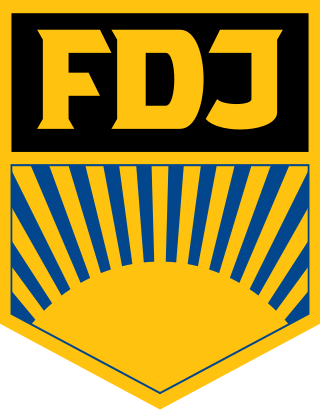
The Free German Youth is a youth movement in Germany. Formerly, it was the official youth movement of the German Democratic Republic (GDR) and the Socialist Unity Party of Germany.

Günter Schabowski was an East German politician who served as an official of the Socialist Unity Party of Germany, the ruling party during most of the existence of the German Democratic Republic (GDR). Schabowski gained worldwide fame in November 1989 when he improvised a slightly mistaken answer to a press conference question about the future of the Berlin Wall. That raised popular expectations much more rapidly than the government planned and so massive crowds gathered the same night at the Wall, which forced its opening after 28 years. Soon afterward, the entire inner German border was opened.

The original Constitution of East Germany was promulgated on 7 October 1949. It was heavily based on the Weimar Constitution and nominally established the GDR as a liberal democratic republic. In 1968, the East German government adopted a new, fully Communist constitution that was based on Marxism–Leninism, political unitarism, and collective leadership. There were further amendments to the 1968 constitution in 1974. With the political events of 1989, there were attempts to draft a new constitution for East Germany, but these efforts never materialized due to the dissolution of East Germany and the accession of its states into the neighboring Federal Republic.
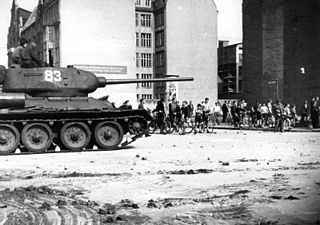
The East German uprising of 1953 was an uprising that occurred in East Germany from 16 to 17 June 1953. It began with strike action by construction workers in East Berlin on 16 June against work quotas during the Sovietization process in East Germany. Demonstrations in East Berlin turned into a widespread uprising against the Government of East Germany and the Socialist Unity Party the next day, involving over one million people in about 700 localities across the country. Protests against declining living standards and unpopular Sovietization policies led to a wave of strikes and protests that were not easily brought under control and threatened to overthrow the East German government. The uprising in East Berlin was violently suppressed by tanks of the Soviet forces in Germany and the Kasernierte Volkspolizei. Demonstrations continued in over 500 towns and villages for several more days before eventually dying out.
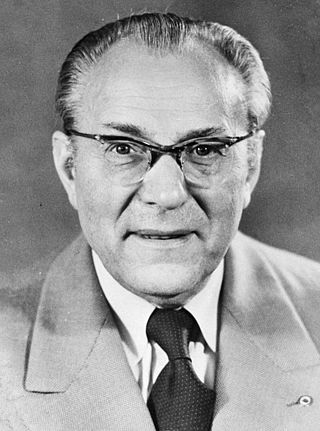
Otto Emil Franz Grotewohl was a German politician who served as the first prime minister of the German Democratic Republic from its foundation in October 1949 until his death in September 1964.
These are lists of political office-holders in East Germany. The political leadership of East Germany was distributed between several offices. However, until the Volkskammer removed a section in the GDR's constitution guaranteeing their monopoly on political power on 1 December 1989, the Socialist Unity Party of Germany (SED) held ultimate power and authority over state and government. Thus, the head of the SED's Politburo of the Central Committee was the de facto leader of the country.

The economy of the German Democratic Republic was a command economy following the model of the Soviet Union based on the principles of Marxism-Leninism. Sharing many characteristics with fellow COMECON member states — the East German economy stood in start contrast to the market and mixed economies of Western Europe, including West Germany. The state established production targets, set prices, and also allocated resources, codifying these decisions in comprehensive plans. The means of production were almost entirely state-owned. The GDR had an above-average standard of living compared to other Eastern Bloc countries or the Soviet Union, and enjoyed favorable duty and tariff terms with the West German market; in 1989, it was estimated that 50 to 60% of its trade was with Western countries. However by the mid-1980s its economy had reached a state of stagnation, contributing to the process of German reunification.

The Peaceful Revolution, as a part of the Revolutions of 1989, was the process of sociopolitical change that led to the opening of East Germany's borders with the West, the end of the ruling of the Socialist Unity Party of Germany (SED) in the German Democratic Republic in 1989 and the transition to a parliamentary democracy, which later enabled the reunification of Germany in October 1990. This happened through non-violent initiatives and demonstrations. This period of change is referred to in German as Die Wende.
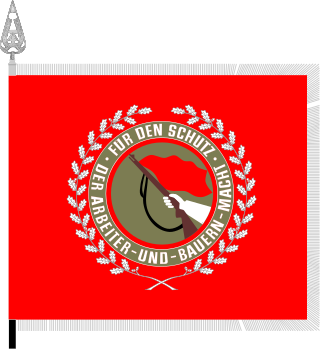
The Combat Groups of the Working Class was a paramilitary organization in the German Democratic Republic (GDR) from 1953 to 1989.
As with many Soviet-allied countries prior to the fall of the Berlin Wall, the government of the former German Democratic Republic applied censorship during its existence from 1949 to 1990. The censorship was practised through a hierarchical but unofficial censorship apparatus, ultimately controlled by the ruling party (SED). Through censorship, the socialist point of view on society was ensured in all forms of literature, arts, culture and public communication. Due to the lack of an official censorship apparatus, censorship was applied locally in a highly structured and institutionalized manner under the control of the SED.
The Council of Ministers was the cabinet and executive branch of the German Democratic Republic from November 1950 until the country was reunified on 3 October 1990. Originally formed as a body of 18 members, by 1989 the council consisted of 44 members.
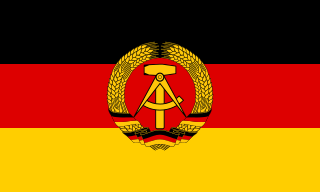
The German Democratic Republic (GDR), German: Deutsche Demokratische Republik (DDR), often known in English as East Germany, existed from 1949 to 1990. It covered the area of the present-day German states of Mecklenburg-Vorpommern, Brandenburg, Berlin, Sachsen, Sachsen-Anhalt, and Thüringen. This area was occupied by the Soviet Union at the end of World War II excluding the former eastern lands annexed by Poland and the Soviet Union, with the remaining German territory to the west occupied by the British, American, and French armies. Following the economic and political unification of the three western occupation zones under a single administration and the establishment of the Federal Republic of Germany in May 1949, the German Democratic Republic was founded on 7 October 1949 as a sovereign nation.
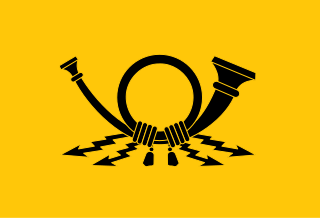
The Deutsche Post (DP), also Deutsche Post of the GDR was the state-owned postal and telecommunications monopoly of the German Democratic Republic. The DP was placed under the control of the Ministry for Postal and Telecommunication Services of the GDR(Ministerium für Post- und Fernmeldewesen der DDR - ) - a member of the Council of Ministers of the GDR(Ministerrat der DDR) - and was in operation from 1949 until the reunification of Germany on 3 October 1990.

Gerhard Beil was a politician for the SED and the Minister for Foreign Trade of the GDR.

Throughout their existence East Germany and the Soviet Union maintained close diplomatic relations. The Soviet Union was the chief economic and political sponsor of East Germany.
Allgemeine Anzeigen GmbH, abbreviated Ala was a central advertising agency of the Nazi Party, created in 1926 from "Ausland GmbH". It was part of the Alfred Hugenberg group, taken over by the Eher Press in 1934 in order to improve the advertising position of the National Socialist Gau presses.
Hans-Joachim Spremberg was an East German news photographer with the state news agency. His photographs documented high-profile state occasions along with daily life in East Berlin. He died as the result of a helicopter accident while on an assignment in Libya.

The Foreign policy of East Germany was characterized by the close ties of East Germany to the Eastern Bloc. During its existence, the most important partner was the Soviet Union (USSR), which acted as a protecting power and most important trade and economic partner, which is why the GDR was called a satellite state. The GDR remained closely linked to the other socialist states through organizations such as the Warsaw Pact and Camecon. While the GDR was relatively isolated outside the communist world in the first two decades of its existence due to the Hallstein Doctrine of West Germany, a change took place in the 1970s with the rapprochement with West Germany under Chancellor Willy Brandt's new Ostpolitik. As a result, the GDR was able to gain international status and establish diplomatic relations with almost 130 countries. While the Marxist-Leninist state ideology played a major role in the foreign policy of the East German government, it was however also influenced by their own economic and political interests. From the 1970s onwards, the GDR increasingly emancipated itself from the Soviet Union and pursued an independent policy towards West Germany, as loans from the West had become vital for the GDR's survival. In the 1980s, Erich Honecker refused to implement liberalizing reforms, which alienated the GDR from the USSR under Mikhail Gorbachev. After the revolutions of 1989, the Eastern Bloc collapsed and Germany was reunified, ending the period of an independent East German foreign policy.